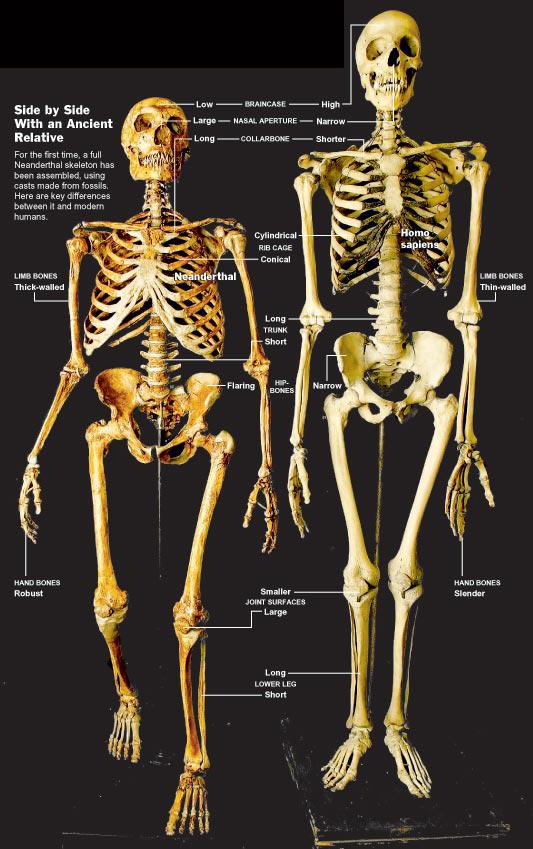
A Neanderthal and a “Modern Man” side by side Mathilda's Anthropology blog
The Fate of the Neanderthals
200 000 – 24 000 BP
H.neanderthaliensis compared to “Modern Humans”
aka
H.sapiens sapiens,or Cro Magnon in French

A
Neanderthal and a “Modern Man” side by side Mathilda's
Anthropology blog
Although modern humans share 98%
of their nuclear DNA with the extinct Neanderthals, the two
species do not share any mitochondrial DNA, which in primates
is always maternally transmitted. This observation has prompted the
hypothesis that whereas female H. sapiens sapiens interbreeding with
male Neanderthals were able to generate fertile offspring, the
progeny of female Neanderthals who mated with male H. sapiens sapiens
were either rare, absent or sterile in line with Haldane's
rule: The hybrids from these pairings would lack Neandertal
mtDNA, since mtDNA is passed only from the mother. But the male
offspring would have Neandertal Y chromosomes. This is where
Haldane’s rule kicks in: these males in their turn would not
reproduce. Therefore only the female hybrids would pass on their
genes. These females obviously don’t pass on a Y chromosome. And,
they would pass on their non-Neandertal mother’s mtDNA.
While
interbreeding is viewed as the most parsimonious interpretation of
the genetic discoveries, the authors point out they cannot
conclusively rule out an alternative scenario, in which the source
population of non-African modern humans was already more closely
related to Neanderthals than other Africans were, due to ancient
genetic divisions within Africa.
Among the genes shown to differ
between present-day humans and Neanderthals were RPTN, SPAG17, CAN15,
TTF1 and PCD16 (Pääbo
et al, 2010)
No supporting evidence has been found in
mitochondrial DNA analyses of modern Europeans, suggesting at least
that no direct maternal line originating with Neanderthals has
survived into modern times
Wikipedia
Archaic human admixture with modern Homo sapiens is suspected by some
to have occurred at least twice in history: with Neanderthals and
with the Denisova hominin. A minimum estimated 1% to 4% of the DNA in
Europeans and Asians (i.e. French, Chinese and Papua probands) is
non-modern, and shared with ancient Neanderthal DNA rather than with
Sub-Saharan Africans (i.e. Yoruba and San probands). However, in
August 2012, a study by scientists at the University of Cambridge has
questioned this conclusion, hypothesising instead that the DNA
overlap is a remnant of a common ancestor of both Neanderthals and
modern humans. A minimum additional estimated 4–6% of Melanesian
DNA is from the archaic Denisovan hominins from Asia. Recent DNA
analysis also indicates Sub-Saharan African admixture with a now
extinct archaic population, possibly Homo erectus.
Wikipedia
Admixture
Good General
Text to Neanderthal evolution
Neanderthal
mtDNA Analysis Mezmaiskaya
The Origins of the Neanderthals
300 000 -24 000 BP
Google-Map of Neanderthal Sites and their Migration
The Neanderthals are the only species of Homo which originated in Greater Europe. They did not emigrate Out of Africa themselves. However the place of their speciazation and its date are not known. Their migrations following the archeological evidence have taken them all over Western and Eastern Europe, the Levant, and the Middle East. Earliest Neanderthal bones from around 200 000 - 80 000 BP were found in England and in Israel – and possibly in Atapuerca, Spain. Around 20 000 BP the last Neanderthals died in Spain and Portugal – equally unexplained. The genetic analysis of the Neanderthal genome has just begun. Maybe it will eventually answer the questions of their birth and disappearance. - So far theories abound.
Atapuerca Sima de los
Huesos
Central Spain
H.antecessor/ heidelberngesis/
Neanderthal? -
300-200 000 BP
The Atapuerca
complex encompasses 9 extended caves with large finds of fossils,
human and animals, going back 1.2 Million years. Of primary interest
here are Grand Dolina (levels TD 11 to TD 1, 850 – 780 000
BP) and the Sima de los Huesos (350 -200 000 BP), the largest
human bone pit ever found (over 5000 pieces, some complete);
containing H. heidelbergensis, H. antecessor, and possibly “proto
H. neanderthaliensis”.
In my unqualified opinion Atapuerca may
be the place of speciazation of the Neanderthals in Europe, who did
not come Out of Africa directly. The issue is hotly debated. The
following are a number of references to this professional dispute:
P.
Pettitt
Heidelberg
or Neanderthal pit of bones?
Hominids from Sima Huesos
Arsuanga
et al
Bontnewydd Palaeolithic Site
Wales, UK
Neanderthal?
230 000 BP?
A
most improbable location and date for a potential Neanderthal
emergence is this Paleolithic site in England. Could these be bones
of H. heidelbergensis?
Bontnewydd was excavated from 1978 by a team from the University of
Wales, led by Dr Stephen Aldhouse Green. Teeth and part of a jawbone
excavated in the cave in 1981 were dated to 230,000 years ago. The
bone is from a Neanderthal(?) boy approximately eleven years old. The
site is the most north-western site in Eurasia for remains of early
hominids and would constitute one of the earliest Neanderthal
finds.
Wikipedia
Near Eastern Neanderthal Sites
The Evolution of Neanderthal and H. sapiens Burial Customs
The alternative and professionally preferred Neanderthal
speciazation site has long been the Levant with several sites dating
to 80 000-45 000 BP.
The problem is that there are no obvious
Neanderthal predecessors in the Levant – except, (highly unlikely)
the first exodus of an early, Archaic H. sapiens from Ethiopia around
125 000 BP, which was abandoned when the climate turned cold and arid
around 75 000 BP. Some anthropologists doubt that the two species
ever met in the Levant before 60 000-45 000 BP when H. sapiens
returned from the Indian Subcontinent after the Tuba explosion (73
000 BP)
Cave at Shanidar
Site
in the Middle-East (modern Iraq)
Neanderthals
80 - 60 000
BP
One of the earliest encounters between Neanderthals and
H.sapiens on their way from the Indian Subcontinent to Western Europe
took place in today’s Iraq.

An
artist's rendering of the Flower Burial of Shanidar 4
Of the ten Neanderthal skeletons found at the cave, it is Shanidar 4
which provides the best evidence for a Neanderthal burial ritual. The
skeleton of an adult male aged from 30–45 years was discovered in
1960 by Ralph Solecki The skeleton was positioned so that he was
lying on his left side in a partial fetal position.
Routine soil
samples which were gathered for pollen analysis in an attempt to
reconstruct the palaeoclimate and vegetational history of the site
from around the body were analysed eight years after its
discovery.
In two of the soil samples in particular, whole clumps
of pollen were discovered in addition to the usual pollen found
throughout the site and suggested that entire flowering plants (or at
least heads of plants) had entered the grave deposit.
Furthermore,
a study of the particular flower types suggested that the flowers may
have been chosen for their specific medicinal properties. Yarrow,
Cornflower, Bachelor's Button, St. Barnaby's Thistle, Ragwort or
Groundsel, Grape Hyacinth, Joint Pine or Woody Horsetail and
Hollyhock were represented in the pollen samples, all of which have
long-known curative powers as diuretics, stimulants, astringents as
well as anti-inflammatory properties. This led to the idea that the
man could possibly have had shamanic powers, perhaps acting as
medicine man to the Shanidar Neanderthals
Wikipedia
There exist two new findings related to violent encounters between H.
sapiens and Neanderthals. Shanidar is the oldest.
New
research suggests that Shanidar 3 (another adult male) may have
been killed by a human being. Using modern-day forensics, Steven
Churchill (Duke University) has determined that Shanidar 3's
wound was most likely caused by a thrown spear. "There's
only one species that had the sort of weapon to inflict this injury,"
Churchill says. "And that's us [H. sapiens sapiens]." The
Neanderthals did not know thrown spears. Churchill found that the
weapon that killed Shanidar 3 entered at about a 45-degree downward
angle. According to Churchill, "That's consistent with the
ballistic trajectory of a thrown weapon, assuming that Shanidar 3 —
who was about 5 ft. 6 in. [1.67 m] tall — was standing."
Churchill also found that Shanidar 3's rib had started healing before
he died. Churchill hypothesized that Shanidar 3 probably died within
a few weeks of the injury.....
A second example (30-28 000 BP) of a potential ritual killing of a Neanderthal child by Anatomically Modern Humans (AMH) comes from Les Rois in Southern France (Ramirez Rozzi et al, 2009)
Another example of a killing of a possible Neanderthal(?) man is seen further below in a cave painting at Pech-Merle, Lot, France, 25-16 000 BP.
El Tabun Cave
Israel
Archaic H. sapiens?
120-40 000 BP
El Tabun Cave is an excavated site located at Mount Carmel, Israel, which was occupied intermittently during the Lower and Middle Paleolithic ages to around 40,000 BP. In the course of this period, deposits of sand, silt and clay of up to 25 meters accumulated in the cave. Excavation suggests that it features one of the longest sequences of human occupation in the Levant.
The Tabun Cave contains a Neanderthal-type(?) female, dated to about 120 000 BP. It is one of the most ancient human skeletal remains found in Israel, - If the date is not inflated, the woman was an Archaic H.sapiens not a Neanderthal. - See comments below under Qafzeh.
Kiyik Koba
Crimean
Neanderthals
70
000 BP?
Kiyik Koba may have been a retreat for Neanderthals after the Tuba explosion 73 000 BP
Kiyik-Koba 1, a Neandertal partial skeleton (canine, partial hands,
partial leg, and feet), of a 40-year-old probable male, exhibits a
suite of pathological lesions, including hypercementosis, minor
fibrousossifications, pedal phalangeal fracture, and
pronouncedenthesopathies on the patella and calcanei in the context
of no articular degenerations
A second individual, the Kiyik-Koba
2 infant, was buried in close proximity to the adult in a separate
grave, similarly excavated through Level VI. Subsequent to its
burial, an additional excavation during the Middle Paleolithic
disturbed the remainsof Kiyik-Koba 1 and removed most of the
skeleton, leaving a tooth, portions of both hands, the right lower
leg, and two virtually complete pedal skeletons.
Trinkaus
et al
Nahal Amud Cave
Israel
Neanderthals
70-50
000 BP
Two University of Tokyo expeditions to the site in 1961 and 1964 unearthed Neanderthal skeletal remains dating from about 50,000 to 70,000 years ago. The principal finds consist of a skeleton (designated Amud 1) of an adult male about 25 years old, along with a fragment of another adult jaw and skull fragments of two infants. Amud 1 has a cranial capacity of about 1,740 cubic cm (106 cubic inches), which is significantly larger than the average capacity of modern humans. Nonetheless, the skull has Neanderthal features, with browridges and a receding forehead. Though the bones are incomplete, the height of Amud 1 has been estimated at 172–177 cm (68–70 inches).
In 1991 a joint Israeli and American expedition began new
excavations. The following year workers uncovered the partial
skeleton of an 8 to 10-month-old Neanderthal baby (Amud 7), upon
whose pelvis had been placed the maxilla of a red deer, apparently as
a burial rite. Further evidence of Neanderthal habitation and
Mousterian toolmaking were revealed, including flaked blades and
points as well as deer, cattle, horse, pig, and fox remains. Other
hominin remains have been uncovered nearby in the Emireh, Shovakh,
and Zuttiyeh caves.
Britannica
Skhul and Qafzeh
Sites
Israel
Archaic H.
sapiens not
Neanderthals!
120-80 000 BP
These two sites together with Kebara, Amud, Ksar Akil (which are the main Levantine Neanderthal sites) were the main support for the Levantine Origin of Neanderthals theory. This theory has in the past 3 years been put to rest by new datings and the suggestion that H.sapiens exited Africa twice 125 000 BP and 80 000 BP.
The hominid remains found at these two sites exhibit a mix of archaic and modern traits. They have now been dated at about 80,000-120,000 years old using electron spin resonance and thermoluminescence dating techniques. Their brain cases are similar to modern humans, but they possess brow ridges and a projecting facial profiles similar to the Neanderthals. They were initially regarded as transitional fossils between Neanderthals and modern humans [Origin of Neanderthals]. They are now regarded as a separate lineage from the Neanderthals, and may represent one of the first exodus of modern humans from Africa around 125,000 years ago.
Neanderthal remains have been found nearby at Kebara Cave that date to 61,000-48,000 years ago, and it has been suggested that the Skhul/Qafzeh H. Sapiens hominids had died out by 80,000 BP because of a climate deterioration. This would suggest that the two types of hominids never made contact in the region. Recent DNA analysis (2010) had revealed that "non-Africans" contain 1-4% Neanderthal genetic material and it had been suggested that hybridization took place in the Middle East.
However, the Skhul/Qafzeh
hominids showed "Neanderthal features" before the arrival
of Neanderthals in the region, suggesting that the robust features of
the Skhul/Qafzeh hominids represent archaic H.sapiens features.
Furthermore it has been suggested that the Skhul/Qafzeh H.sapiens
hominids are an extinct lineage, and that modern humans exited Africa
a second time around 70,000 years ago crossing the Arabian Peninsula
into theMiddle East, the Indian Subcontinent and beyond. .
Wikipedia
Kebara Cave
Israel
Neanderthals
60- 48 000 BP
The oldest occupations at Kebara Cave are thought to be associated with the Middle Paleolithic Aurignacian and Mousterian traditions, and range between 60 000 and 48 000 years ago. These oldest levels yielded thousands of animal bones - primarily mountain gazelle and Persian fallow deer - many of the bones with cutmarks, as well as burned bones, hearths, ash lenses and lithic artefacts leading researchers to believe Kebara Cave was a long-term occupied base camp for its Neanderthal residents. Also identified in the MP layers of Kebara cave was a nearly complete skeleton of a Neanderthal, known as KMH 2 or Kebara 2.

Neanderthal
hyoid bone from Kebara (64 000 - 60 000 BP)
The crucial bone of the Kebara II skeleton is this hyoid
bone, which was missing in earlier Neanderthal fossil skulls. It
enables man to articulate speech. It debunks the myth (eg Jean Auel)
that they could not speak.
The positions of the mandible, the
hyoid bone, and the right upper third molar, which fell from its
socket next to the right lower third molar, exclude the hypothesis
that the skull was removed by an animal. Furthermore, no cranial
fragments were found. These observations suggest that the skull was
removed by humans following the complete decay of the
atlanto-occipital ligaments.
This is, in our view, the first clear-cut case recorded in a
Mousterian context for later human intervention in a primary burial.
The absence of the skull precludes any further interpretations in
terms of mortuary practices.
The estimation of the stature of KMH
2 at ~1.74 m, for example, is consistent with observations previously
made on Near Eastern Middle Palaeolithic hominids had a mean stature
taller than that of classical European Neanderthals.
Quote, text
and photo from Don's
Maps
More see Wikipedia
Kebara
Also Britannica,
Neanderthal
Ksar Akil
Lebanon
Neanderthals
and H. sapiens after 52 000 BP
60-45 000 BP
Excavations showed occupational deposits reaching down to a depth of
23.6 metres (77 ft) with one of the longest sequences of Paleolithic
flint industries found in the Middle East. The first level of 8
metres (26 ft) contained Upper Levalloiso-Mousterian (Neanderthal)
remains with long and triangular Lithic flakes.
A fragment of a
Neanderthal maxilla was discovered in material from level XXVI or
XXV, at around 15 metres. Artifacts recovered from these lebvels
include shells with holes and chipped edge modifications that may
have been used as pendants or beads. These indicate that the
inhabitants were among the first in Western Eurasia to use personal
ornaments.
The cave was reoccupied by H. sapiens around 52-48 000 BP after their return from the Idian Subcontinent (73 000 BP).
This second move of H.sapiens out of Africa is demonstrated by the Upper Paleolithic culture, (Ksar Akil XXV level, 52-50,000 BC) with modern human remains. Stephen Oppenheimer suggests that this reflects a movement of modern human into North Africa (Haua Fteah Cave, Algeria)).
It would appear this sets the date by which Homo sapiens cultures
begin replacing Neanderthals and by c. 40,000 BC Palestine was
occupied by the Levanto-Aurignacian Ahmarian H.sapiens culture,
lasting from 39-24,000 BC. This culture was quite successful in
spreading as the Antelian culture (late Aurignacian), as far as
Southern Anatolia.
Last 2 paragraphs condensed from Wikipedia
Mezmaiskaya
Northern
Caucasus
Neanderthals
40-30 000 BP
Preliminary excavations recovered Mousterian (Neanderthal) artefacts,
dated to about 35,000 B.P. and older, in the middle of the last
glacial period. However, a rib fragment from the partial skeleton of
a Neanderthal infant found in the cave was radiocarbon-dated to
29,195 ± 965 B.P., and therefore belongs to the last living
Neanderthals. The value obtained from the bone itself rather than
from associated material gives the most reliable date for this
individual. Ancient DNA was recovered for a mtDNA sequence showing
3.48% divergence from that of the Feldhofer Neanderthal, some 2,500
km to the west in Germany. Phylogenetic analysis places the two in a
clade distinct from modern humans, suggesting that their mtDNA has
not contributed to the modern human mtDNA pool.
Wikipedia
Western European Neanderthals
In Western Europe (Fance, Spain, and Portuga) Neanderthals lived at least from 70 000 -20 000 BP, and between 45 000 and 20 000 in very close, though not always peaceful contact with “Modern Man” (French: Cro Magnon). Genetic evidence so far obtained shows that they did not interbreed in appreciable numbers. The great cave paintings were all painted by Cro Magnon artists.
Roc de Marsal
Dordogne,
France
H.neanderthalensis
70 000 BP
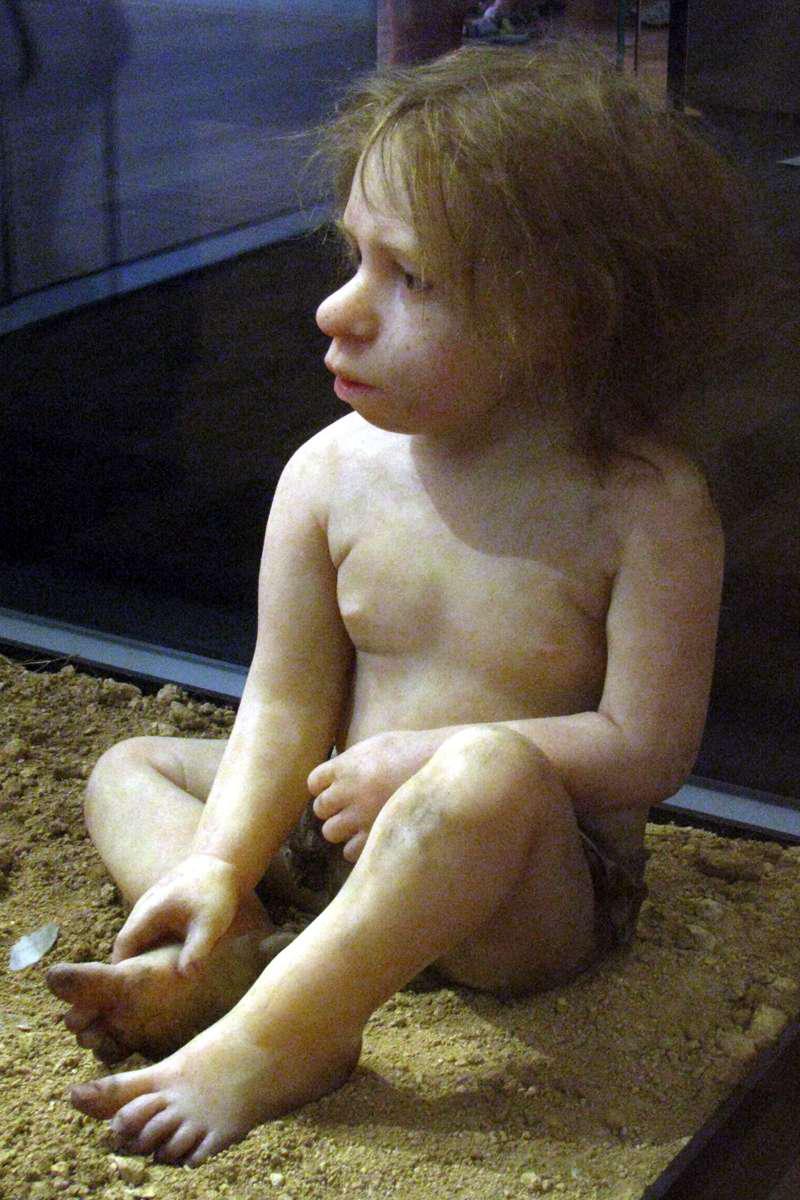
The
three year old Neanderthal child of Roc de Marsal, one of the oldest
burials of the Perigord
Reconstuction (Musée National de
Préhistoire, Les Eyzies), by Elizabeth
Daynès
This three year old child discovered in 1961 at Roc de Marsal (a
rockshelter with several adult, classical Neanderthal burials) enjoys
an exceptional state of preservation. The body seems to have been
deposited in a natural depression in the ground, and has been
apparently forced into the form of an arc of a circle, lying on its
stomach, with a hand to its head and legs bent at 90°, and then
immediately covered with soil. Recent excavations suggest a date of
around 70 000 BP, which makes Roc de Marsal one of the oldest burials
of the Perigord.
Photo and text
Don's Maps
La Ferrassie Rock Shelter
Perigord, France
H. neanderthalensis
70 - 50 000 BP
The site of La Ferrassie is one of two deposits in the world to have broadly contemporary multiple burials. A Neanderthal cemetery. The subjects belong to different age groups, and thus give a good picture of the population.
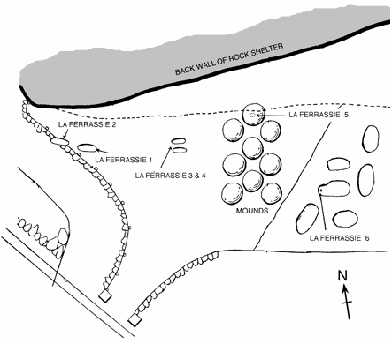
Burial
sites in the La Ferrassie rock shelter Plan P.
Pettitt
The site yielded skeletons from eight Neanderthal individuals, including 2 adults, 2 children, 2 infants, and 2 fetuses! All were ceremonially buried at the shelter. They were discovered on 17th September 1909 by R. Capitan and D. Peyrony.
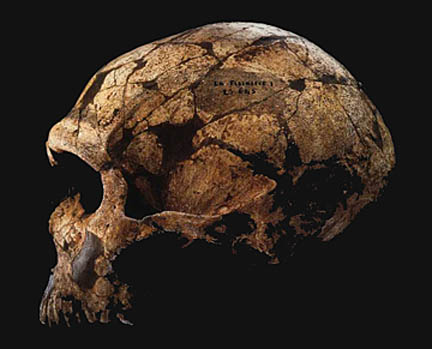
Neanderthal
skull La Ferrassie 1
This provides a measure of the size Neanderthal groups had approached at the time. These highly structured groups were able to care for older and frailer individuals who did not contribute directly to the material life of the group. These individual burials, were intended to protect the body after death. This reflects true humanity. Text: Don's Maps

Neanderthal
handprints at Ferrassie 60 000 BP
Peyzac-le-Moustier
Dordogne
H. neanderthalensis
40 300 BP
Fossil remains of adult Neanderthals are well documented, but juvenile specimens are rare and information about them is scant. Here we identify a beautifully preserved four-months-old skeleton that has been lost to science for almost 90 years as the Neanderthal neonate known as ‘Le Moustier 2’, which was originally found at Le Moustier. The burial pit originated in archaeological level J, a Mousterian cultural layer that has been dated to 40 300±600 years BP by thermoluminescence
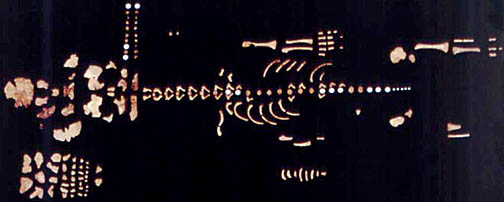
The
nearly complete skeleton of the Moustier 2 neonate baby, 40 300 BP
Estimates of he stature based on the length of the long bones
confirmed that the age at death was no more than four months.
Although Le Moustier 2 is one of the most complete Neanderthal
individuals to have been discovered, both scapulae and the pubis are
missing. However, the right femur and right humerus, which were
previously also missing, have now been found,
Don's
Maps
Neanderthal
Germany,
name site of the species
40 000 BP
Discovered by Johann Carl Fuhlrott (1856), Feldhofer 1 or Neanderthal
1 is the common name for the initial 40,000-year-old Neanderthal
specimen found in Kleine Feldhofer Grotte in August 1856. It
represents the beginning of paleoanthropology as a scientific
discipline.
The discovery was made in Feldhofer grotto in a
limestone quarry located in Neanderthal, Germany. Neanderthal 1
consisted of a skull cap, two femora, the three right arm bones, two
of the left arm bones, ilium, and fragments of a scapula and ribs.
The fossils were given by quarry workers to a local teacher and
amateur naturalist, Johann Karl Fuhlrott. The description of the
remains was determined by anatomist Hermann Schaffhausen. The find
was announced jointly in 1857.
As well as the unique historical
importance of this specimen, it has continued to play a key role
since its discovery
Wikipedia
Are the Burial Customs of H. sapiens sapiens inherited from the Neanderthals?
Early Burials of “Modern Man”
The excavated Neanderthal sites
all exhibit complex burial rituals, which were eventually adopted by
H. sapiens. These burial customs are so close to our own, modern
sentiments that they are still able to evoke our emotions: From the
dark recess of our common subconsciousness surface thoughts and
attitudes about life and death which despite all advances may
originate with these ancestors. As Confucius said in 500 BC, “about
death I know nothing. That domain I leave to the
priests.”
Neanderthal
Burials
Krems-Wachtberg
near
Krems/Danube, Austria
H. sapiens
27 000 BP
One of the most touching remains of H. sapiens are child burials. The Neanderthals practiced an elaborate child burial ritual long before the arrival of H. sapiens in Europe, and H. sapiens seems have adopted this practice from them.
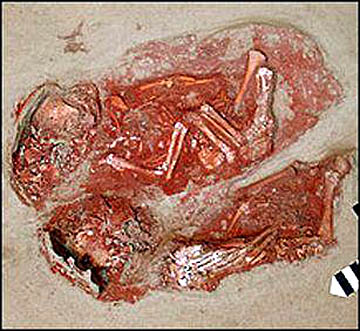
The
"Ice-Age Twins" smothered in red ocher, photo Don's
Maps
In Krems-Wachtberg in 2005 archeologists unearthed the graves of
three Stone Age infants that may ultimately bear on the question of
whether humans interbred with Neanderthals. The rare find, from a 27
000 year old site in Austria, includes two bodies that might be twins
sheltered under a mammoth's shoulder blade. Numerous traces of burial
practice survived. All of the infant remains were covered in red
ocher pigment, and more than 30 ivory beads lay near the pelvis of
one of the twins.
These rituals involved in child burials confirm
the close relation to the contemporaneous south Moravian sites, like
Dolní Věstonice, Pavlov and Předmostí, as evidenced by the use of
red ochre, grave goods like ivory beads and the practice of covering
the grave with a mammoth shoulder blade
Excavation Report Händel
et al (pdf in English
Dolni Vestonice, Moravia
Triple Burial
H. sapiens
25 000 BP
An even more touching burial was found in a mammoth-hunter camp in Moravia, right at the edge of the Würm ice cap: Three people ralated by a common fate were cermoniously interred together. Because of the extremely cold location, the improvised habitat, and other finds at Dolni Vestovince I lean to attribute the site to late Neanderthals – alas the professionals don't agree.
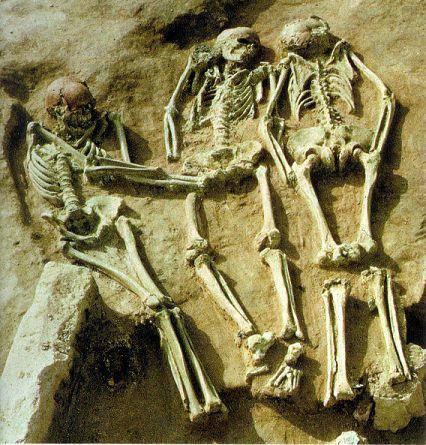
The
Triple Burial of Dolni Vestonice
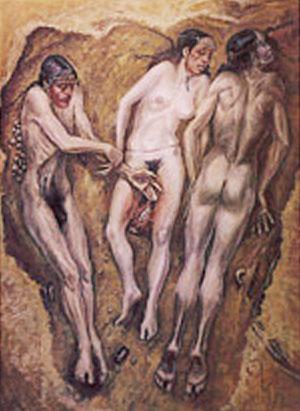
An
artist's rendition
The following is taken from James Shreeve's book “The Neandertal Enigma: solving the mystery of modern human origins” (William Morrow and Company, New York, 1995.)
In the spring of 1986, near a village called Dolni Vestonice in the
Czech province of Moravia, the bodies of three people were discovered
in a common grave.
Two of the skeletons were heavily built males.
By its slender proportions, the third was judged to be female, aged
seventeen to twenty. A marked left curvature of the spine, along with
several other skeletal abnormalities, suggested that she had been
painfully crippled. The two males had died healthy, in the prime of
their lives. The remains of a thick wooden pole thrust through the
hip of one of them hinted that his death might not have been entirely
natural.
The bodies had been buried with curious attention.
According to the expert Bohuslav Klima, of the Czech Institute of
Archaeology in Brno both young men had been laid to rest with their
heads encircled with necklaces of pierced canine teeth and ivory; the
one with the pole thrust up to his coccyx may also have been wearing
some kind of painted mask. All three skulls were covered in red
ocher.
The most peculiar feature of the grave, however, was the
arrangement of the deceased. Whoever committed the bodies to the
ground extended them side by side, the woman between her two
companions. The man on her left lay on his stomach, facing away from
her but with his left arm linked with hers. The other male lay on his
back, his head turned toward her. Both of his arms were reaching out,
so that his hands rested on her pubis. The ground surrounding this
intimate connection was splashed with red ocher.
The skeletons
lean into each other, like nestled question marks. In his written
report, Klima speculated that the arrangement of the grave might
reflect "a real life drama which precipitated the burials."
His drama revolved around a young woman who had died in childbirth.
The two male skeletons where those of her husband and a medicine
man-the man wearing the mask. Held responsible for her death, the men
had been compelled to follow her into the afterlife.
Photos and
text from Don's
Maps
Did “Modern Man” interbreed with (and persecute) Neanderthals?
The genetic answer to the interbreeding question has been discussed at the beginning of this chapter. The second part of the question is not easily addressed. Explanations of the demise of the Neanderthals range from their being “marginalized” by the culturally superior AHM (Anatomicaly Modern Humans), to cannibalism and explicit persecution of Neanderthals by “Modern Man”. There are indications that the latter actually happened. They are weak and only a few, which I have collecteded in the following examples.
In the end cultural pressures on the dwidling Neanderthal groups surely played a major role. They moved to the far borders of H. sapiens' territory in Portugal and southern Spain, where, probably helped by epidemics and alcohol, the last Neandertal communities died in the 20th millenium BP much like the American Indians and other ethnic minorites disappeared in modern times.
Pech-Merle
Lot,
France
Decidedly an H.sapiens site
25-16 000 BP
See
my discussion of the paintings
of Pech-Merle
Pech Merle, a hillside opening in the Lot département of the Midi-Pyrénées region in France, about 35 minutes drive east of Cahors, is one site of prehistoric cave paintings in France remaining open to the general public. Going back inside for more than a mile are caverns with walls painted in dramatic murals dating back to 25,000 BP (Gravettian culture). Some of the paintings and engravings could be later (Magdalenian, 16, 000 BP).
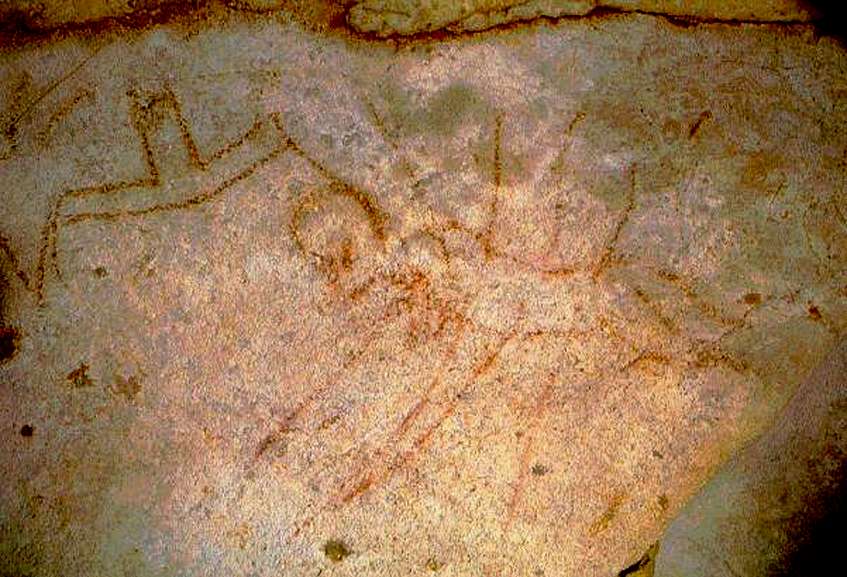
A
man killed by 8 spears next to a “Placard Sign”, 75 cm high,
Solutrean 20 000 BP? Photo Michel
Lorblanchet
The most enigmatic findings in several caves in the area are a signs
dubbed: “aviforms” (in the shape of birds wings - “Vultures or
Eagles!”). It has been suggested that these signs, which are found
in the Charente (Le Placard) and in the Departement Lot (Pech Merle,
Cougnac),
stand for a group with a common goal, who convened in these caves
separated more than 150 km from each other.
A depiction of a
speared man is equally rare (there exist 2 other such drawings).
Possibly the associated Placard Sign indicates war fare between two
such tribes or groups: “kill the bastard!”
This raises the interesting question: were the killed man a
Neanderthalian and the aviform-group H.sapiens Racists? There exists
an earlier example of a potential killing of a Neanderthal man by H.
sapiens sapiens from
Shanidar.
For more on Pech-Merle see Wikipedia
Pech Merle
and Don's
Maps
Grotte de Cougnac
north of Gourdon, Lot, France
Cro Magnon site
25 000+14 000
BP
See my page on the Cave
Paintings of Cougnac
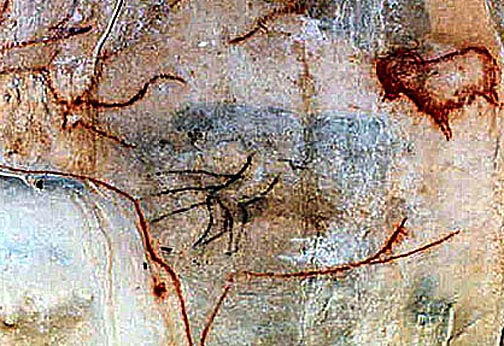
Another
example of a charcoal graffiti of a man killed by spears, Cougnac
megaloceros, 14 000 BP
Abrigo do Lagar Velho
East
of Mariha Grande, Portugal
24 500 BP
Burial of a child with mixed H.sapiens/neanderthal skeletal characteristics
In archaeological terms, the site is known to integrate a
stratigraphic sequence representative of much of the Upper
Paleolithic human occupations of the region (between about 30,000 and
20,000 years), gathering at various levels respective traces and
carved lithic remnants, associated with coeval faunal elements.
In
1998, the discovery of an early Upper Paleolithic human burial site
in the valley has provided evidence of early modern humans in
southern Iberia. The remains, the largely complete skeleton of an
approximately 4-year-old child, was buried with a pierced shell and
red ochre (dated to circa 24,500 years B.P.).
The cranium,
mandible, dentition, and postcrania appear to present a mosaic of
European early modern human and Neanderthal features, although this
interpretation is disputed. If the child was indeed a hybrid of
anatomically modern humans and homo neanderthalensis, there could be
significant implications regarding the Neanderthal interaction with
Cro-Magnons and the taxonomical classification of these (possibly
sub-) species.
In addition to providing evidence of a 25,000 year
old ritual burial (decorated with burnt pine branches, red ochre,
pierced bear teeth and shell adornments) of a 4 year old Paleolithic
child, an analysis has revealed that the child exhibits distinctive
characteristics of both contemporaneous European early modern humans
and Neandertals. It therefore provides evidence of admixture between
Neandertals and early modern humans in southwestern Europe. As a
result, it has become a focus of ongoing research by Prof. Trinkaus
and others concerning the evolutionary dynamics of the emergence of
modern humans across the Old World. - No DNA analysis has as yet been
pubished. Was the child a girl?....
Wikipedia
Cidalia
Duarte et al, Excavation Report, June 1999
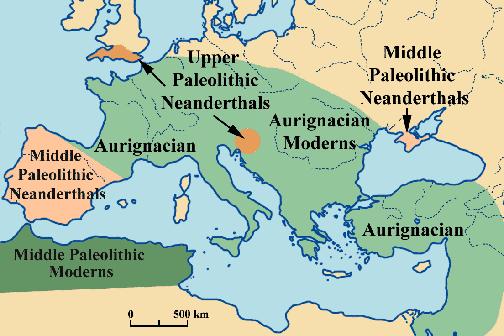
Map
of the Last Neanderthals ca. 30 000 BP
Map from an article by João Zilhão: The Lagar Velho Child and the Fate of the Neanderthals
Around 25 000 BP the Neanderthals disappeared as a distinct population from the archeological record except for a few straggling settlements in Portugal, Southern Spain, the Balkans, and in Southern England. Whether they were killed by “Modern Man”, succumbed to viral diseases, alcohol, or simply died out because they couldn't adapt to the modern life style cannot be assertained. Their sentimental Gemüt (soul), and especially their burial rituals and understanding of life and death survived subliminally in many parts of Europe to the present.
Iberian Aurignacian Sites 40 000-18 000 BP
The
last refuges of the Neanderthals.
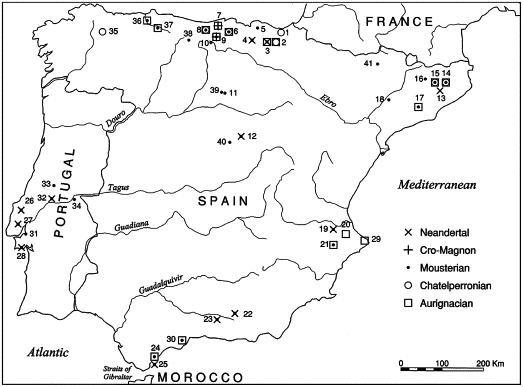
Selected sites with Mousterian, Châtelperronian and/or Aurignacian industries, Neandertal or Cro-Magnon remains in Iberia.
Key to site numbers: 1. Ekain 2. Labeko Koba 3. Lezetxiki 4. Axlor 5. Kurtzia 6. Cueva Morin 7. Camargo 8. E1 Pendo 9. E1 Castillo 10. La Flecha 11. Millan 12. Los Casares 13. Banyoles 14. L’Arbreda 15. Reclau Viver 16. Els Ermitons 17. Romani 18. Roca dels Bous 19. Cova Negra 20. Les Mallaetes* 21. Beneito 22. Cariguela 23. Zafarraya 24. Gorham's Cave* 25. Devil's Tower 26. Columbeira 27. Salemas 28. Figueira Brava 29. Foradada* 30. Bajondillo* 31. Conçeicão 32. Almonda 33. Caldeirão 34. Foz da Enxarrique 35. A Valiña 36. E1 Conde 37. La Viña 38. Esquilleu 39. La Ermita 40. Jarama IV 41. Las Fuentes de San Cristobal*: “Aurignacian” here is either problematic or chronologically late.
Source file of map: http://ars.els-cdn.com/content/image/1-s2.0-S1040618204002356-gr1.gif
Les Rois sur Boëme
near
Mouthiers-sur-Boëme, Charente, France
Cro Magnon site
30
000-28 000 BP
A second hybrid child - or a ritual killing of a Neanderthal child?
The spread of Anatomically Modern Humans (AMH) into Europe, is supported by few diagnostic human remains, including those from the Aurignacian site of Les Rois in south-western France. Here we reassess the taxonomic attribution of the human remains, their cultural affiliation, and provide five new radiocarbon dates for the site.
Patterns of tooth growth along with the morphological and
morphometric analysis of the human remains at Les Rois indicate that
a juvenile mandible showing cutmarks presents some Neandertal
features, whereas another mandible is attributed to Anatomically
Modern Humans.
A Reappraisal of the archaeological sequence
demonstrates that human remains derive from two layers dated to 28–30
kyr BP attributed to the Aurignacian, the only cultural tradition
detected at the site
Three possible explanations may account for this unexpected evidence.
The first one is that the Aurignacian was exclusively produced by
AMH and that the child mandible from unit A2 represents evidence for
“defleshing” or, more likely, a symbolic killing (not
cannibalism!) of a Neandertal child by Aurignacian AMH.
The
second possible explanation is that Aurignacian technologies were
produced at Les Rois by human groups bearing both AMH and Neandertal
features. Human remains from Les Rois would be in this case the first
evidence of a biological contact between the two human groups.
The
third possibility is that all human remains from Les Rois represent
an AMH population with conserved plesiomorphic characters suggesting
a larger variation in modern humans from the Upper Palaeolithic.
From
Fernando
V. Ramirez Rozzi et al, "Cutmarked human remains bearing
Neandertal features and modern human remains associated with the
Aurignacian at Les Rois."
Nouvelles
fouilles sur Les Rois
Did the Neanderthals paint Caves?
Nerja Caves
Malaga,
Spain
22 000 BP and possibly
>37 000 BP?
No cave paintings can be associated with Neanderthals for sure with
the exception of the hand stencils in La Ferrassie (60 000 BP).
Recently drawings in Nerja cave have been attributed - though
unproven and not very convincingly argued - by Spanish
paleoanthropologists to Neanderthals.
Skeletal remains found in the lower, open caverns, Nerja I, indicate that they were inhabited from about 25,000 BC up until the Bronze Age. Cave paintings from the Paleolithic and post-Paleolithic eras have been discovered on the walls of the upper cave, Nerja II. For about 4,000 years around 25,000 BC the caves were used seasonally by a small group of humans, and were occupied by cave hyenas during the periods that the humans were absent. By 21,000 BC the human population had taken up year-round residence in the cave and had increased in number. A culture based on hunting in the local area had evolved, illustrated by first cave paintings found in the cave which date to around 21 000 BC.
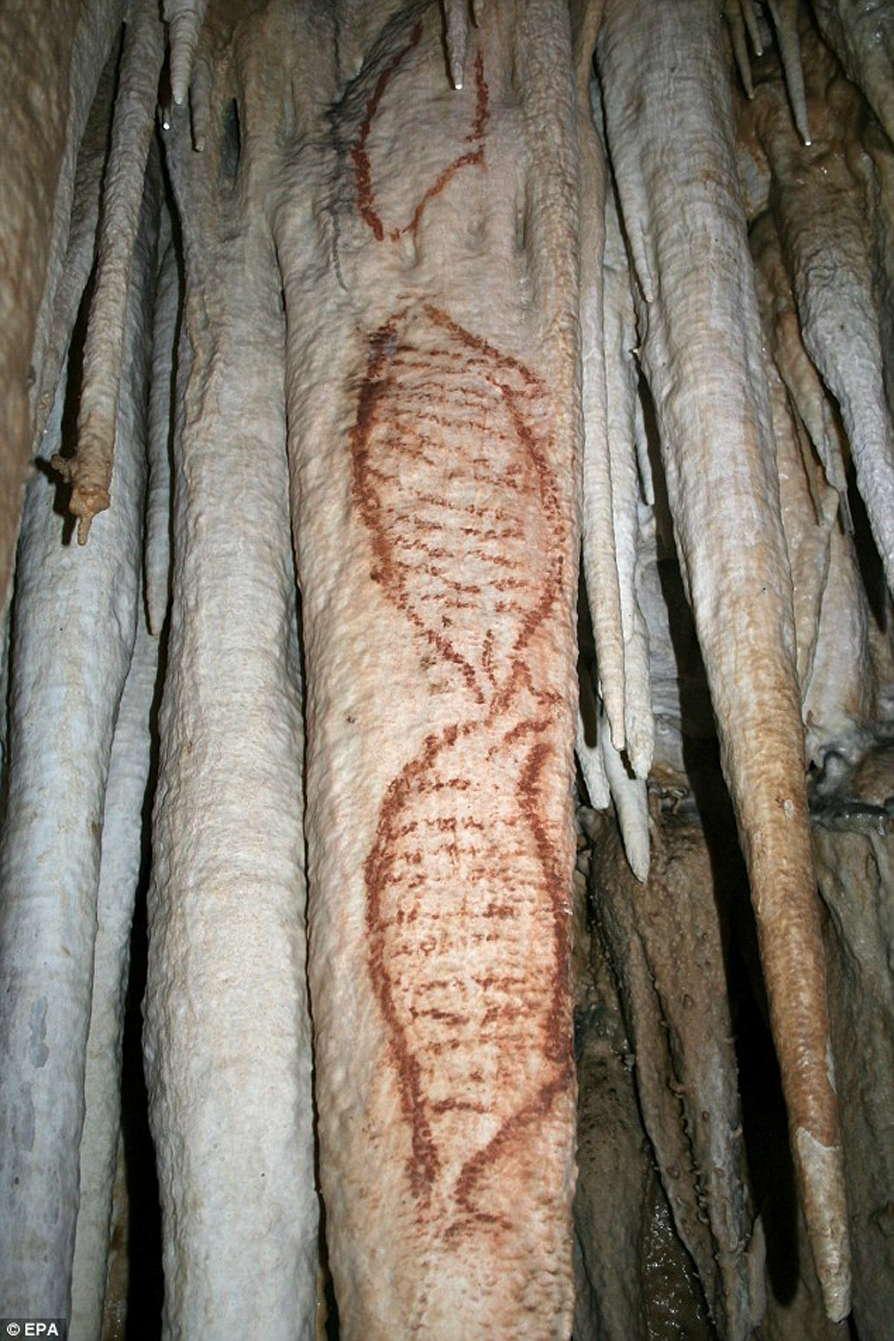
The
latest sensation (2012): drawings of seals possibly by Neanderthals,
estimated date >37 000 BP
These two seals recently dicovered, are advertized to be the first
drawings attributable to Neanderthals. Dating of the Nerja seal
paintings' pigments will not take place until after 2013. Further
excavations in the extensive upper cave system, closed to the public,
is ongoing.
New
Scientist 2012
Wikipedia